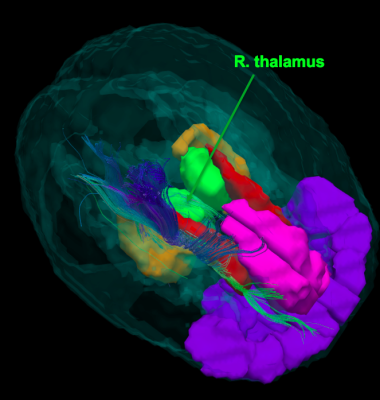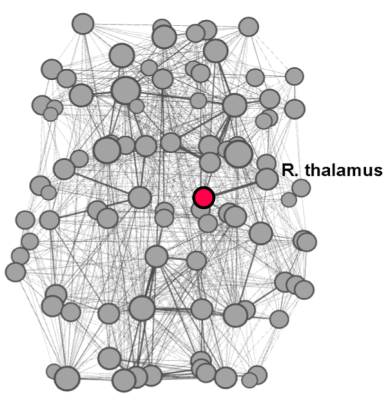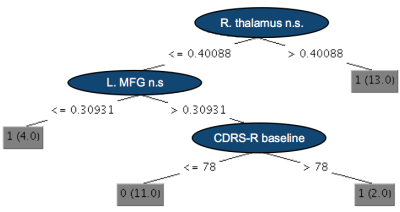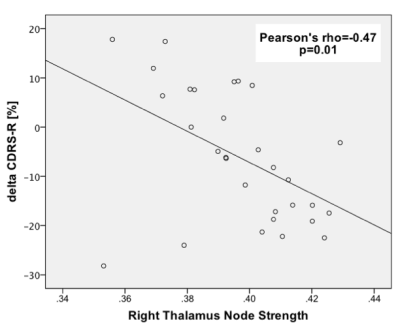0228
A DTI connectome and machine learning approach to predict symptom improvement in depressed adolescents with cognitive-behavioral therapy (CBT)1University of California, San Francisco, San Francisco, CA, United States, 2Florida State University, Tallahassee, FL, United States, 3Umea University, Umea, Sweden
Synopsis
We applied machine learning to DTI-based structural connectome data in order to predict improvement of symptoms in 30 depressed adolescents with cognitive-behavioral therapy (CBT). The J48 pruned tree classifier was applied with a 10-fold cross-validation, resulting in an 83% accuracy. The resulting tree highlights the role of the thalamus, a region known to be directly involved in anticipatory anhedonia and generation of goal-directed behavior, the lack of which can make subsequent CBT ineffective. The gained knowledge can significantly improve treatment planning in cases of adolescent depression and help optimize and develop new preventive and therapeutic interventions for this devastating disorder.
INTRODUCTION
Adolescent depression is a highly prevalent, incapacitating and costly illness. Unfortunately, a large percentage of depressed adolescents do not respond to cognitive behavioral therapy (CBT), the most established psychotherapy approach [1]. Non-responders face devastating consequences of increased risk of suicide and many negative health outcomes. “Who will respond to CBT?” is a crucial question and our ability to answer it could significantly improve treatment planning. The objective of this study was to apply machine learning to MRI-based structural connectome data in order to predict improvement of symptoms in depressed adolescents with CBT.METHODS
The diffusion tensor imaging (DTI)-based connectome was reconstructed in 30 adolescents ages 13-17 diagnosed with major depressive disorder (MDD) as described previously [2] (Figs. 1, 2). Depression symptoms were assessed clinically using the Children’s Depression Rating Scale-Revised (CDRS-R) at baseline and after three months, during which the patients underwent CBT treatment. A set of 21 attributes was selected for the machine learning analysis, including the baseline depression score, age, gender, two global network properties weighted by fractional anisotropy (FA) (average clustering coefficient and characteristic path length) and FA-weighted node strengths of 16 nodes corresponding to eight brain regions (right and left) previously implicated in depression [3]: amygdala, insula, anterior cingulate cortex (ACC), orbitofrontal cortex (OFC), middle frontal gyrus (MFG), hippocampus, caudate, and thalamus. The J48 pruned tree classifier (JAVA implementation of the C4.5 algorithm in WEKA [4]), which is based on the concept of information entropy, was applied with a stratified 10-fold cross-validation.
RESULTS
Nineteen patients showed an improvement of the depressive symptoms, whereas 11 did not show improvement. The J48 classification resulted in an 83% accuracy of predicting symptom improvement, a statistically significantly better result than what can be obtained by chance (ZeroR). The resulting tree of size seven with only three attributes (Fig. 3) highlights the role of the right thalamus in predicting the improvement with CBT in adolescents diagnosed with MDD (Figs. 1, 2). The other two leaves were the baseline depression score and the node strength of the left MFG. Additional analysis showed a significant negative correlation between the percent change in the depression symptoms and the node strength of the right thalamus (Fig. 4), meaning that teens with higher node strength demonstrated better improvement (more negative delta CDRS-R).
DISCUSSION
Our results show that a machine learning algorithm that exclusively uses structural connectome data and the baseline depression score can predict with a high accuracy CBT treatment response in adolescents suffering from MDD. This knowledge can significantly improve treatment planning in cases of adolescent depression. Equally important, the results shed light on the underlying mechanisms of responsiveness to CBT and can help optimize and develop new preventive and therapeutic interventions for adolescent MDD. In particular, our results highlight the role of the right thalamus in predicting the improvement. According to published research thalamus is directly involved in anticipatory anhedonia [5-7] and in the generation of goal-directed behavior [8], the lack of which can make subsequent CBT treatment ineffective [9].
Acknowledgements
This study was supported by NCCIH R21AT009173 to OT, TY and EHB; by NICHD R01HD072074 to DX and OT; by UCSF Research Evaluation and Allocation Committee (REAC) and J. Jacobson Fund to OT, EHB, TY and DX; by the Swedish Research Council 350-2012-303 to EHB; by NIMH R01MH085734 to TY; by the Brain and Behavior Research Foundation (formerly NARSAD) to TY.References
[1] The TADS Team. The Treatment for Adolescents With Depression Study (TADS): Long-term Effectiveness and Safety Outcomes. Arch Gen Psychiatry. 2007;64:1132-1143.
[2] Tymofiyeva O, Connolly CG, Ho TC, Sacchet MD, Henje Blom E, LeWinn KZ, Xu D, Yang TT. DTI-based connectome analysis of adolescents with major depressive disorder reveals hypoconnectivity of the right caudate. J Affect Disord. 2017;207:18-25.
[3] Pandya M, Altinay M, Malone DA, Anand A. Where in the Brain Is Depression? Curr Psychiatry Rep. 2012;14:634-642.
[4] Quinlan R. C4.5: Programs for Machine Learning. Morgan Kaufmann Publishers, San Mateo, CA. 1993.
[5] Li Z, Yan C, Xie W-Z, Li K, Zeng Y-W, Jin Z, Cheung EFC, Chan RCK. Anticipatory pleasure predicts effective connectivity in the mesolimbic system. Front Behav Neurosci. 2015;9:217.
[6] Knutson B, Westdorp A, Kaiser E, Hommer D. FMRI visualization of brain activity during a monetary incentive delay task. Neuroimage. 2000;12:20-27.
[7] Komura Y, Tamura R, Uwano T, Nishijo H, Kaga K, Ono T. Retrospective and prospective coding forpredicted reward in the sensory thalamus. Nature. 2001;412:546-549.
[8] Haber SN, Calzavara R. The cortico-basal ganglia integrative network: the role of the thalamus. Brain ResBull. 2009;78:69-74.
[9] Alvares GA, Balleine BW, Guastella AJ. Impairments in Goal-Directed Actions Predict TreatmentResponse to Cognitive-Behavioral Therapy in Social Anxiety Disorder. PLoS ONE. 2014;9:e94778.
Figures



